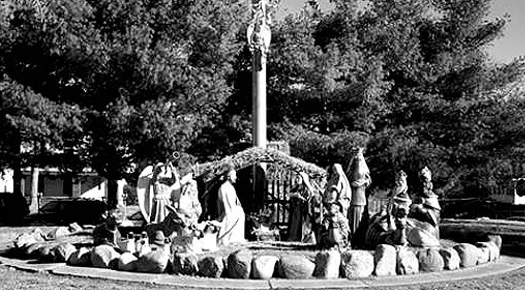
A federal judge recently dismissed a lawsuit challenging the constitutionality of a nativity scene that has been placed on the courthouse lawn of Franklin County, Indiana. The American Civil Liberties Union (ACLU) filed the lawsuit last year against county officials, accusing them of violating the Constitution’s First Amendment by allowing public property to be used for promoting one religion over another.

However, that allegation is no longer valid, Federal District Judge Tanya Walton Pratt pointed out last month, since a newly passed ordinance already allows residents of Franklin County to display their own exhibits, irrespective of whether they are religious, on the courthouse lawn. County officials passed the ordinance within a month of the lawsuit being filed.
“Given the fact that the policies for Courthouse displays were changed upon Franklin County's own volition (albeit under the pressure of the instant litigation), the Court finds that there is no reasonable expectation that the allegedly unconstitutional activity will recur and there is no proof presently which suggests that Franklin County has committed a constitutional violation,” Pratt wrote.
However, the ruling does not specify whether a government entity is privy to placing religious displays on public property.
Jocelyn Floyd, attorney for Thomas More Society, which is representing Franklin County, said the Establishment Clause has not been violated in this case, since county residents have equal access to the courthouse lawn regardless of what kind of exhibit they want to display there. The ruling came less than a year after the ACLU sued Franklin County on behalf of the Freedom From Religion Foundation (FFRF) and two county residents, who objected to the religious display.
Gavin Rose, staff attorney for the ACLU, said in a statement that he was disappointed with Pratt’s ruling.
“We are reviewing the decision with our clients to decide on what the next steps, if any, are. We have 30 days to appeal,” Rose said.
Thomas More Society said on the other hand that Pratt’s ruling serves as a victory for free speech and religious liberty.
“The decision reaffirms the right of private citizens to exercise their religious faith in the public square. This dismissal is also a solid precedent for counties and cities seeking to fend off nuisance lawsuits by the Freedom From Religion Foundation,” Peter Breen, Thomas More Society's special counsel, said in a statement.
The nativity scene has been displayed on the courthouse lawn for over five decades and it is constituted of life-size figurines of baby Jesus, mother Mary, Joseph and the three wise kings.
As early as 2010, the FFRF started sending letters to county officials, asking them to remove the unconstitutional religious display from public property. However, the officials ignored these letters and allowed residents to continue building the nativity scene on the courthouse lawn until the ACLU filed the lawsuit in December 2014. Then, county officials briefly removed the exhibit and soon passed an ordinance, stating that residents could use the courthouse lawn for demonstrations, events, rallies, exhibits, wedding ceremonies and press conferences. All that the residents would have to do before displaying their exhibits is apply for a permit, which according to Floyd would be granted regardless of what the residents would want to display on the courthouse lawn.
So far, county officials have granted two permits – one for the nativity scene and another for a winter solstice display.
“That shows you that there's no pretense here,” Floyd said. “It's not that they put the ordinance in place and we're just going to do whatever we want regardless.”
Photo Credits: Freedom from Religion Foundation
